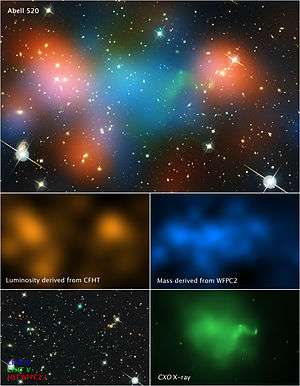Abell 520
| Abell 520 | |
|---|---|
|
Abell 520. Imaged January 2012. Credit: NASA | |
| Observation data (Epoch J2000) | |
| Constellation(s) | Orion |
| Right ascension | 04h 54m 03.80s[1] |
| Declination | +02° 53′ 33.00″[1] |
| Number of galaxies | 289+[2] |
| Richness class | 3[3] |
| Bautz-Morgan classification | III[3] |
| Velocity dispersion | 1,066 km/s[2] |
| Redshift | 0.2[4][5] |
| Distance (co-moving) |
811 Mpc (2,645 Mly) h−1 0.705 [1] |
| ICM temperature | 9.8 keV[5] |
| Binding mass |
17×1014 h−1 0.70[2] M☉ |
| X-ray luminosity | 14.44×1044 erg/s (0.1–2.4 keV)[5] |
| X-ray flux | 8.4×10−12 erg s−1 cm−2 (0.1–2.4 keV)[5] |
| Other designations | |
| The Train Wreck Cluster | |
| See also: Galaxy groups, Galaxy clusters, List of galaxy clusters | |

The Abell 520 galaxy cluster possesses an unusual substructure resulting from a major merger. It has been popularly nicknamed The Train Wreck Cluster,[6][7][8] due to its chaotic structure, and is classified as a Bautz-Morgan type III cluster.[3] It is at a co-moving radial distance of 811 Mpc (2,645 Mly) and subtends 25 arcminutes on the sky.[1] Analysis[2] of the motions of 293 galaxies in the cluster field suggested that Abell 520 was a cluster forming at the crossing of three filaments of the large scale structure
The surprising substructure of Abell 520 was reported in 2007 from a weak gravitational lensing study based on Canada-France-Hawaii-Telescope (CFHT) imaging data. It was surprising because the study found the "dark core" with a significant amount of mass in the region, where there is no concentration of bright cluster galaxies. No conventional understanding of dark matter can explain this peculiar concentration of dark matter.[7][6] One interesting interpretation is that the substructure may arise from non-gravitational interaction of dark matter.
However, in the year 2012 two international teams of astronomers published conflicting results on Abell 520. While one study[9] based on the Wide Field Planetary Camera 2 (WFPC2) on Hubble Space Telescope (HST) confirmed the previous claim of the dark core in Abell 520, the other study[10] based on the Advanced Camera for Surveys (ACS) did not support the claim.
In 2014, the conflicts were resolved by the study,[11] which analyzed the data from both teams and showed that in fact the ACS data also confirm the presence of the dark core. As of 2016, the "dark core" mystery in Abell 520 still remains.
See also
References
- 1 2 3 4 "NED results for object ABELL 0520 - BASIC DATA for ABELL 0520". NASA/IPAC EXTRAGALACTIC DATABASE. Retrieved March 3, 2012.
- 1 2 3 4 Girardi, M.; Barrena, R.; Boschin, W.; Ellingson, E. (Nov 2008). "Cluster Abell 520: a perspective based on member galaxies. A cluster forming at the crossing of three filaments?". Astronomy and Astrophysics. 491 (2): 379–395. arXiv:0809.3139
 . Bibcode:2008A&A...491..379G. doi:10.1051/0004-6361:200810549.
. Bibcode:2008A&A...491..379G. doi:10.1051/0004-6361:200810549. - 1 2 3 Table 3, page 24 in Abell, George O.; Corwin, Harold G., Jr.; Olowin, Ronald P. (May 1989). "A catalog of rich clusters of galaxies" (PDF). Astrophysical Journal Supplement Series. 70 (May 1989): 1–138. Bibcode:1989ApJS...70....1A. doi:10.1086/191333.
- ↑ Struble, Mitchell F.; Rood, Herbert J. (November 1999). "A Compilation of Redshifts and Velocity Dispersions for ACO Clusters". The Astrophysical Journal Supplement Series. 125 (1): 35–71. Bibcode:1999ApJS..125...35S. doi:10.1086/313274.
- 1 2 3 4 Ebeling, H.; Edge, A. C.; et al. (December 1998). "The ROSAT Brightest Cluster Sample - I. The compilation of the sample and the cluster log N-log S distribution". Monthly Notices of the Royal Astronomical Society. 301 (4): 881–914. arXiv:astro-ph/9812394
 . Bibcode:1998MNRAS.301..881E. doi:10.1046/j.1365-8711.1998.01949.x.
. Bibcode:1998MNRAS.301..881E. doi:10.1046/j.1365-8711.1998.01949.x. - 1 2 "'Cosmic train wreck' stumps dark-matter physicists". Physics World.
- 1 2 "Cosmic 'train wreck' defies dark matter theories - space -". New Scientist. Retrieved 16 August 2007.
- ↑ "Abell 520: Dark Matter Mystery Deepens in Cosmic "Train Wreck"". Retrieved 16 August 2007.
- ↑ Jee, M. J.; Mahdavi, A.; Hoekstra, H.; Babul, A.; Dalcanton, J. J.; Carroll, P.; Capak, P. (2012-03-01). "A Study of the Dark Core in A520 with the Hubble Space Telescope: The Mystery Deepens". The Astrophysical Journal. 747: 96. arXiv:1202.6368
 . Bibcode:2012ApJ...747...96J. doi:10.1088/0004-637X/747/2/96.
. Bibcode:2012ApJ...747...96J. doi:10.1088/0004-637X/747/2/96. - ↑ Clowe, Douglas; Markevitch, Maxim; Bradac, Marusa; Gonzalez, Anthony H.; Chung, Sun Mi; Massey, Richard; Zaritsky, Dennis (2012-10-01). "On Dark Peaks and Missing Mass: A Weak-lensing Mass Reconstruction of the Merging Cluster System A520". The Astrophysical Journal. 758: 128. arXiv:1209.2143
 . Bibcode:2012ApJ...758..128C. doi:10.1088/0004-637X/758/2/128.
. Bibcode:2012ApJ...758..128C. doi:10.1088/0004-637X/758/2/128. - ↑ Jee, M. J.; Hoekstra, H.; Mahdavi, A.; Babul, A. (2014-03-01). "Hubble Space Telescope/Advanced Camera for Surveys Confirmation of the Dark Substructure in A520". The Astrophysical Journal. 783: 78. arXiv:1401.3356
 . Bibcode:2014ApJ...783...78J. doi:10.1088/0004-637X/783/2/78.
. Bibcode:2014ApJ...783...78J. doi:10.1088/0004-637X/783/2/78.
External links
- Universe Today, Galaxy Cluster Collision Creates a Dark Matter Core
- Dark Matter Core Defies Explanation
Coordinates: ![]() 04h 54m 03.80s, +02° 53′ 33.00″
04h 54m 03.80s, +02° 53′ 33.00″
